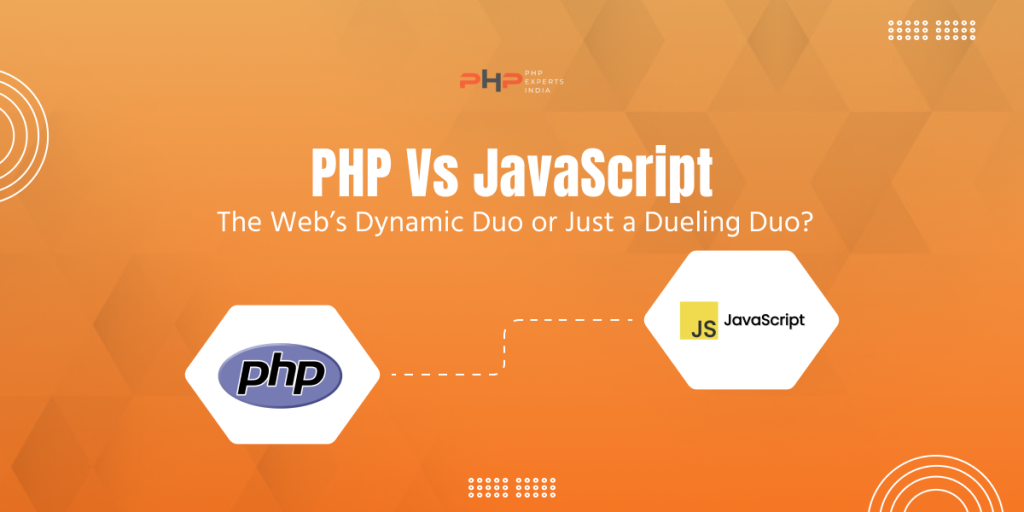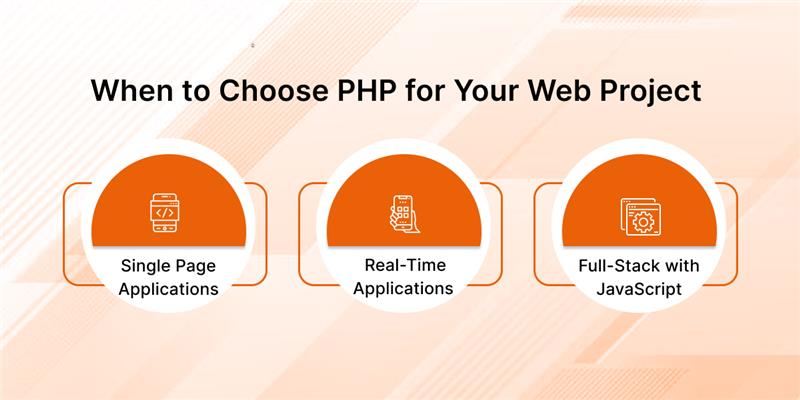
PHP vs. JavaScript: Selecting the Best Technology for Your Project
PHP vs JavaScript: The Web’s Dynamic Duo or Just a Dueling Duo?
When you think of the internet’s most iconic sites—Facebook, Wikipedia, WordPress—and what is making it all happen? PHP and JavaScript are probably behind the scenes. But working with them is no easy feat. PHP handles the server-side heavy lifting, while JavaScript dances on the client side, making things interactive and smooth. It can be tough deciding which one to choose for your project, but what if you don’t have to choose at all?

This article takes a closer look at PHP vs JavaScript, highlighting when to use each and how they can work together to create seamless, high-performance applications.
PHP vs JavaScript: Understanding the Difference
PHP and JavaScript—the ultimate showdown in web development. While both are powerful scripting languages, they have very different roles.
PHP: The Backend Heavyweight
PHP’s forte is generating dynamic content and connecting with databases (hello, MySQL). Imagine someone walking into a bustling web application and everything looks smooth and seamless. But behind the curtains, there is someone else pulling all the strings to ensure everything runs perfectly. That’s PHP, the unsung hero of backend development.
When comparing JavaScript vs PHP, it’s important to note that PHP shines in server-side scripting, quietly handling everything from data processing to database management. PHP is primarily a server-side scripting language, quietly working behind the scenes to process data, talk to databases, and dynamically generate the content that shows up on your browser.
It handles heavy lifting—user authentication, form processing, database management, and more. While you are browsing the site, PHP is there, working its magic to ensure everything is delivered smoothly and securely, making it the perfect choice for handling the backend of web applications.
Websites like Facebook, WordPress, and Wikipedia owe a lot of their power to PHP running the server-side engine.
JavaScript: The Frontend Showman
Now let’s move onto JavaScript, the magician of the web that makes things move, react, and come alive on your screen. Unlike PHP, which quietly works in the background, JavaScript is the client-side scripting language, handling what users see and interact with. It’s the language behind those cool animations, interactive forms and real-time updates you experience on websites.
Also Read : GET vs POST: Difference Between GET and POST Methods in PHP
Think of JavaScript as the conductor of the orchestra, ensuring every piece of the user interface plays its part smoothly. Therefore, considering JavaScript vs PHP, you will find that PHP is the clear leader when it comes to handling backend functions like form processing and dynamic content generation.
Where PHP builds the web’s foundation, JavaScript builds the flashy, engaging visuals that users can enjoy. With the rise of modern frameworks like React, Angular, and Vue, JavaScript’s role in front-end development has grown even more dominant, allowing developers to create dynamic single-page applications (SPAs) and interactive user interfaces.
Why PHP for Backend and JavaScript for Frontend?

- In the PHP vs JavaScript debate, PHP is built specifically for server-side scripting. It runs on the backend, managing business logic, server requests, and database communication to serve your website’s dynamic content. Interacting with servers and databases to handle requests, retrieve data, and deliver it to the frontend. It’s all about managing business logic and communication with the database to serve up your website’s dynamic content.
- JavaScript, on the other hand, was designed to make webpages interactive by running directly in the browser (client-side). It controls the user interface, updating pages dynamically and making them more engaging without needing to reload the whole page.
When to Choose PHP for Your Web Project
When you need a system that can handle heaps of dynamic content with ease, PHP is your go to option in the debate of PHP vs JavaScript. It’s the secret behind CMS platforms like WordPress, Drupal, and Joomla. These platforms are perfect for users who want to update content or manage a gazillion blog posts and even run an e-commerce shop without reinventing the wheel. When you need a platform to manage your content and look good you can rely on PHP for sure.
Or even for launching an e-commerce site, you need something that can scale with your growing inventory, handle customer transactions securely and provide a smooth shopping experience. That’s when PHP comes into the spotlight. Platforms like Magento and Shopify are built on the sturdy foundation of PHP as it is clear that this language is a pro at handling the backend of e-commerce platforms. Thus, PHP is fast, flexible, and perfect for handling large catalogs, customer data, and processing payments securely.
Also Read : API Integration Tools: Complete Guide with A List of Top 8 Tools
Why PHP is Still King for Backend-Heavy Projects
Here’s the lowdown: PHP is reliable which is perfect for backend-heavy projects because it delivers on performance, security, and an ever-growing library of frameworks. Building a massive CMS, an e-commerce empire, or an enterprise-level application, PHP has got the infrastructure to support it. It’s like having a dependable engine under the hood of your web application—fast, secure, and built to last.
Latest Trend: PHP 8’s New Superpowers
PHP’s not stuck in the past as now with the release of PHP 8 having new features, including the JIT (Just-In-Time) compilation, that boosts performance and optimizes speed. So, if you have been avoiding PHP because it seemed like the slow in the race, think again. With the coming of PHP 8, it is faster, more powerful and ready to tackle large applications.
In short, when you need a backend that handles large-scale content, processes transactions like a pro or supports a growing application, PHP is your best bet. Don’t be fooled by its age—it has evolved and with PHP 8, it’s stronger than ever! So, if you are diving into a backend-heavy project, don’t forget to bring PHP along for the ride. The JavaScript vs PHP debate really boils down to your project needs.
When to Choose PHP for Your Web Project

Alright, so you are eyeing JavaScript for your next web project? Let’s see why this language might just be the secret ingredient your app needs to shine like a freshly polished diamond.
Single Page Applications (SPAs)
Using Gmail or scrolling through Facebook, it feels great pages don’t reload, data updates in real-time, and everything runs as smooth as butter. Behind the scenes? JavaScript frameworks like React.js, Vue.js, or Angular are pulling all the strings. These frameworks are the ultimate enablers of Single Page Applications (SPAs), where the whole app feels like one continuous experience. JavaScript makes sure every click, scroll, and interaction happens instantly without refreshing the page. It’s like a backstage performance for your web app, with JavaScript as the mastermind.
Real-Time Applications
Now, let’s talk about Slack or Trello—two apps you probably have open more often than your email. These are real-time powerhouses where instant messaging or live updates happen at lightning speed. And guess who’s behind it? JavaScript. You will discover that it not only powers the front end, which is what you see, but with the help of Node.js, it also takes care of the back end i.e. what’s happening behind the curtain). With Node.js, JavaScript bridges the gap between frontend and backend, making it the perfect language for real-time apps that need lightning-fast performance. It’s like getting the whole package—client and server sides wrapped up in one neat language.
Read More : Laravel vs Symfony
Latest Trend: Full-Stack with JavaScript
The real twist is that JavaScript is no longer just a front-end hero. As frameworks like React.js, Vue.js, and Next.js gain traction, it has become a one-stop shop for full-stack development. JavaScript is now handling everything from the database to user interface. It is a toolkit which is very versatile, handy, and ready to tackle any part of your app whether it’s running on the client or the server. So, forget about the good old divide between frontend and backend— JavaScript is breaking down barriers, uniting both sides to work in perfect unison.
In short, if you need real-time features, a seamless user experience or a full-stack solution, JavaScript is your go-to sidekick. With its frameworks and Node.js, it’s got both the frontend and backend covered, proving once again that JavaScript is not just a language—it’s a full-stack superhero.
Conclusion
When it comes to the difference between PHP and JavaScript, it’s clear that both languages bring their unique strengths to the table, but the choice between them really depends on your project needs. PHP is your go-to when you need to handle dynamic, data-driven content on the backend and on the other hand, JavaScript shines in scenarios where real-time interactivity and smooth user interfaces are key. It dominates the frontend with dynamic, responsive web pages and single-page applications, and with the rise of Node.js, it can even tackle the backend now, blurring the lines between the two.
So, whether you need a rock-solid backend (PHP) or a seamless, interactive frontend (JavaScript), both can work together to create powerful web applications. The real trick is knowing when to choose which.

